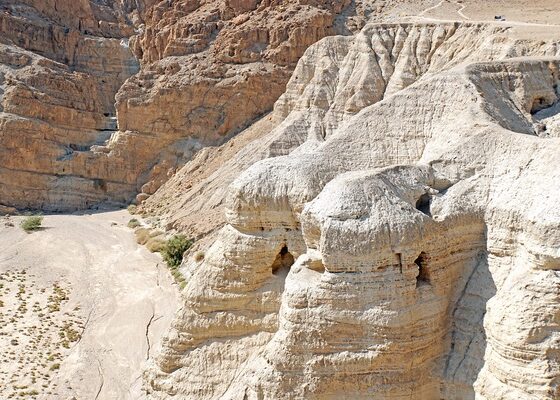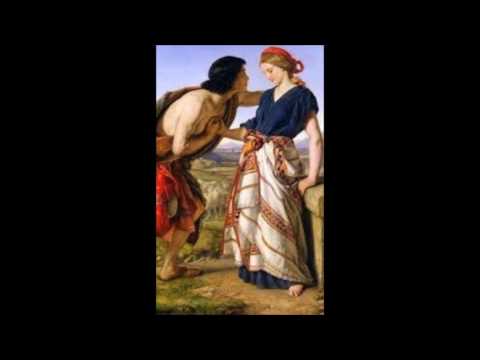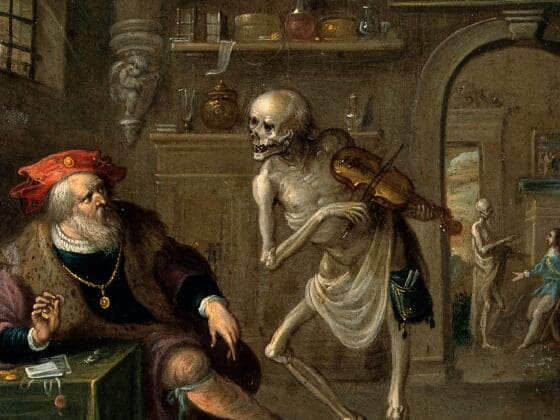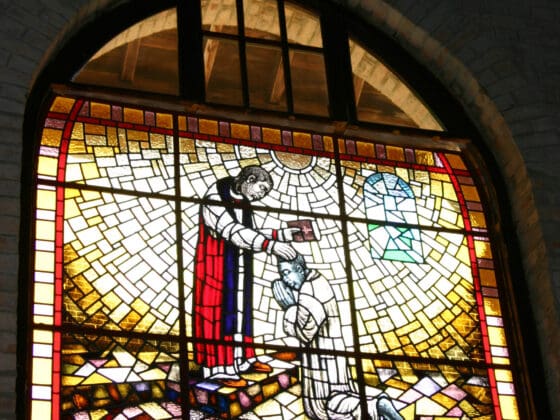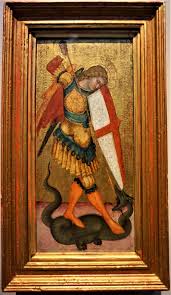I preached this sermon on Easter Wednesday 1990 at Trinity School for Ministry.
I wonder how many of you have read Anne Tyler’s book, or seen the movie, titled The Accidental Tourist. The eccentric hero of the book, Macon Leary, writes guides for tourists whose concern is how to travel as if they had never left home: What hotels in Madrid boasted king-sized Beauty-rest mattresses? What restaurants in Tokyo offered Sweet’n-Low? Did Amsterdam have a McDonald’s? Did Mexico City have a Taco Bell? Did any place in Rome serve Chef Boyardee ravioli?
Some day I hope to write a similar book entitled “The Half-Empty Guide to the Holy Land.” You see, what has most impressed me on my visits to Israel is not how present Jesus is there, but how absent he is. Of course, you can imagine him walking the streets of Nazareth or praying on the Mount of Olives, but you can do that from home as well. When you actually get to some likely New Testament site, you either end up lighting prayer candles in a mausoleum or you pay an Arab boy to take you to some gnarled fig-tree that looks like it must be 2000 years old. Well, you get the gist of my book.
The final chapter will be called “The Half-Empty Tomb” and will point out that to find “where they laid him” you must choose between a site with a sub-terrainian cave (the Orthodox have churched it over) or an ideal Garden Tomb at the wrong site (the place where General Chinese Gordon, surely a half-full traveler, cried “Eureka, I have found it!”.
If I have managed to scandalize you by talking this way in Easter Week, it’s because the empty tomb is a scandal – as much a scandal as the cross or the manger. The empty tomb is a scandal because it is the sign that Jesus is not just risen, but is risen from the dead. And if we want to appropriate the risen life of Christ, we must accept the conditions under which that life was first offered Jesus’ followers – and still is offered to us. Let’s look more closely at the accounts in Mark and Matthew’s Gospels.
St. Mark, I am convinced, is the half-empty evangelist of the four. In his no-nonsense description of Easter morning (Mark 16:1-8, “the short ending”), he reports only that three women came to the tomb, surprisingly found the stone seal rolled back, and inside encountered a young man dressed in white. His message was short and sweet: “Do not be amazed. You seek Jesus of Nazareth. He is risen; he is not here. See the place where they laid him. Now go to Peter because he is going before you into Galilee. There you will see him, as he told you.” The women then rushed out from the tomb in amazement; and they did not report anything “because they were afraid.” The empty tomb, according to Mark, conveyed not spiritual fullness and joy, but astonishment and fear.
By contrast, St. Matthew (28:1-10) seems to have the half-full version of the empty tomb, with all the pyrotechnics of a Hollywood production. There are Roman centurions on duty. The women are greeted by an earthquake, and – shazam! – the angel of the Lord descends from heaven, rolls back the stone and sits on it. Dazzled by his lightning countenance, the guards enter into catatonic shock “as if dead”; upon hearing the good news, the women go out with fear and joy and tell the disciples what has happened. Then, for the first time, they meet the risen Jesus.
Despite these rather dramatic differences between Mark and Matthew’s version of Easter, there remains a hard common core which they share: that is the fact that the tomb is open and that, miraculously, Jesus isn’t in it: “He is not here. He is risen.” No matter how marvelous and miraculous the subsequent appearances, the Gospels do not neglect to say where it all began.
Why is it important for us to hold fast to the remembrance of the empty tomb? Some people, beginning with the Jewish opponents, have always been tempted to believe too little about God’s salvation in Jesus Christ, and usually that temptation begins with scoffing disregard for the moments in which he entered and then transcended history.
It is commonly heard from Episcopal pulpits, on Easter morning no less, that the empty tomb is only a metaphor for the reality of the living Christ, or that Christ rose, not from the tomb but in the hearts of the women at the tomb or among the disciples when they celebrated their first Easter Eucharist. But this is the same mindset that makes Christ’s birth a metaphor and his death an inspiring example of commitment to a cause. And in the end, Jesus Christ himself becomes only a metaphor of how you can “be all that you can be.”
To such thinking, I can only suggest a strong dose of John Updike. In a semi-autobiographical story, “Pigeon Feathers,” Updike describes the formative experience of a rather sickly, sensitive young boy named David who had just read H. G. Wells’ version of the “swoon theory,” that Jesus had survived the cross, staggered out of the tomb, and died elsewhere, thus making Christianity a freakish mistake at best. David finds no consolation but rather indignation when his pastor likens heaven to the goodness of Abraham Lincoln living on.
This indignation occurs again Updike’s poem “Seven Stanzas at Easter”:
Let us not mock God with metaphor,
analogy, sidestepping transcendence;
making of the event a parable, a sign painted in the
faded credulity of earlier ages:
let us walk through the door.
Let us not seek to make it less monstrous,
for our own convenience,
our own sense of beauty,
lest, awakened in one unthinkable hour,
we are embarrassed by the miracle
and crushed by remonstrance.
There is, however, another temptation which may be more prevalent here among us who claim to be born-again, Spirit-filled Christians. If liberals believe too little about the resurrection, renewal folk often believe too much. This was the group at Corinth whom Paul had to warn: “If Christ has not been raised, your faith is futile and you are still in your sins” (1 Corinthians 15:14-17), not because they were skeptical but because they had moved on to deeper knowledge and experiences of the Spirit. Sometimes in renewal circles, there is not so much a denial of the fact of resurrection – the empty tomb – but a practical ignoring of it. If we are filled with the Spirit of the Risen Lord, why do we keep going back to sin and death and resurrection?
The reason, I believe, is that as Christians we never get beyond the empty tomb. “I am crucified with Christ; nevertheless I live” (Galatians 2:20). This is the pattern which Paul lays down for us. Oh, wouldn’t we love to get beyond the dreary round of sin and repentance, of sorrow and joy, of faith and doubt. But God won’t let us.
Monday night our family sat down to dinner, and I was all ready to celebrate, when Peggy served up another “soup night” for our World Vision child in Indonesia. I was somewhat irritated and reminded her that according to the Church calendar, we are supposed to have fifty full days of feasting – or at least for Easter Week. She pointed out that children overseas don’t take off eating for Easter – so soup it was. Not only that – but we threatened the kids (and me – baseball season is beginning) with removing the TV. Happy Easter! – actually it turned out to be one of our better recent family discussions. But it wasn’t all sweetness and light.
I have sensed – and others confirm – that the past weeks at Trinity have been a corporate “downer.” It’s understandable; for the juniors the glow has by now fully worn off their illusions; for middlers the beginning and the end are far off; for seniors everyone in the world is playing with your life and future. Add to that gray weather, colds, mid- terms, a favorite faculty member leaving and seemingly endless Lent and Rite One. Maybe we can hope, as we come back, that Lent’s long shadows have departed. Bishop Frey is coming! Bishop Pytches is coming! Summer is coming! The Lord is coming!
But if for some of you, the trick does not work, remember the empty tomb. God is continually “returning” – returning us to joy and returning us to sorrow. This subject, God’s “returns” is addressed by what I consider the most beautiful poem in English, “The Flower” by George Herbert:
How Fresh, O Lord, how sweet and clean
Are thy returns! ev’n as the flowers in spring;
To which, besides their own demean,
The late-past frosts tributes of pleasure bring.
Grief melts away
Like snow in May,
As if there were no such cold thing.
Who would have thought my shrivel’d heart
Could have recover’d greenness? It was gone
Quite under ground; as flowers depart
To see their mother-root, when they have blown;
Where they together
All the hard weather,
Dead to the world, keep house unknown.
These are thy wonders, Lord of power,
Killing and quick’ning, bringing down to hell
And up to heaven in an hour;
Making a chiming of a passing-bell,
We say amiss,
This or that is:
Thy word is all, if we could spell.
O that I once past changing were;
Fast in thy Paradise, where no flower can wither!
Many a spring I shoot up fair,
Off’ring at heav’n, growing and groaning thither:
Nor doth my flower
Want a spring-shower,
My sins and I joining together;
But while I grow to a straight line;
Still upwards bent, as if heav’n were mine own,
Thy anger comes, and I decline:
What frost to that? what pole is not the zone,
Where all things burn
When thou dost turn,
And the least frown of thine is shown?
And now in age I bud again,
After so many deaths I live and write;
I once more smell the dew and rain,
And relish versing: O my only light,
It cannot be
That I am he
On whom thy tempests fell all night.
These are thy wonders, Lord of love,
To make us see we are but flowers that glide:
Which when we once can find and prove,
Thou hast a garden for us, where to bide.
Who would be more,
Swelling through store,
Forfeit their Paradise by their pride.
The resurrection is the queen of miracles, just as spring is the queen of seasons. It confirms God’s Yes in Jesus. Our sins are forgiven. His Spirit is given. His Church will stand. And we have hope not just for this life but for the world to come “fast in thy Paradise where no flower can wither.”
But the empty tomb roots us in earth. We are not Jesus. He is risen, seated at the right hand of the Father. We live by faith, and thus we shall continue to experience his “returns” – both the fullness of joy and the emptiness of death. Let us embrace them in faith, as Mary embraced the Risen Lord – “ Rabboni”- and Thomas the Crucified One – “My Lord and my God.”
Happy Easter everyone!
I have a later meditation in this blog: “The Empty Tomb: Sacrament of the Material God“
The Hymn for today is St. John of Damascus, “Come Ye Faithful, Raise the Strain of Triumphant Gladness”
Cover Art is a 6th century mosaic of Easter morning (Flickr Commons)

